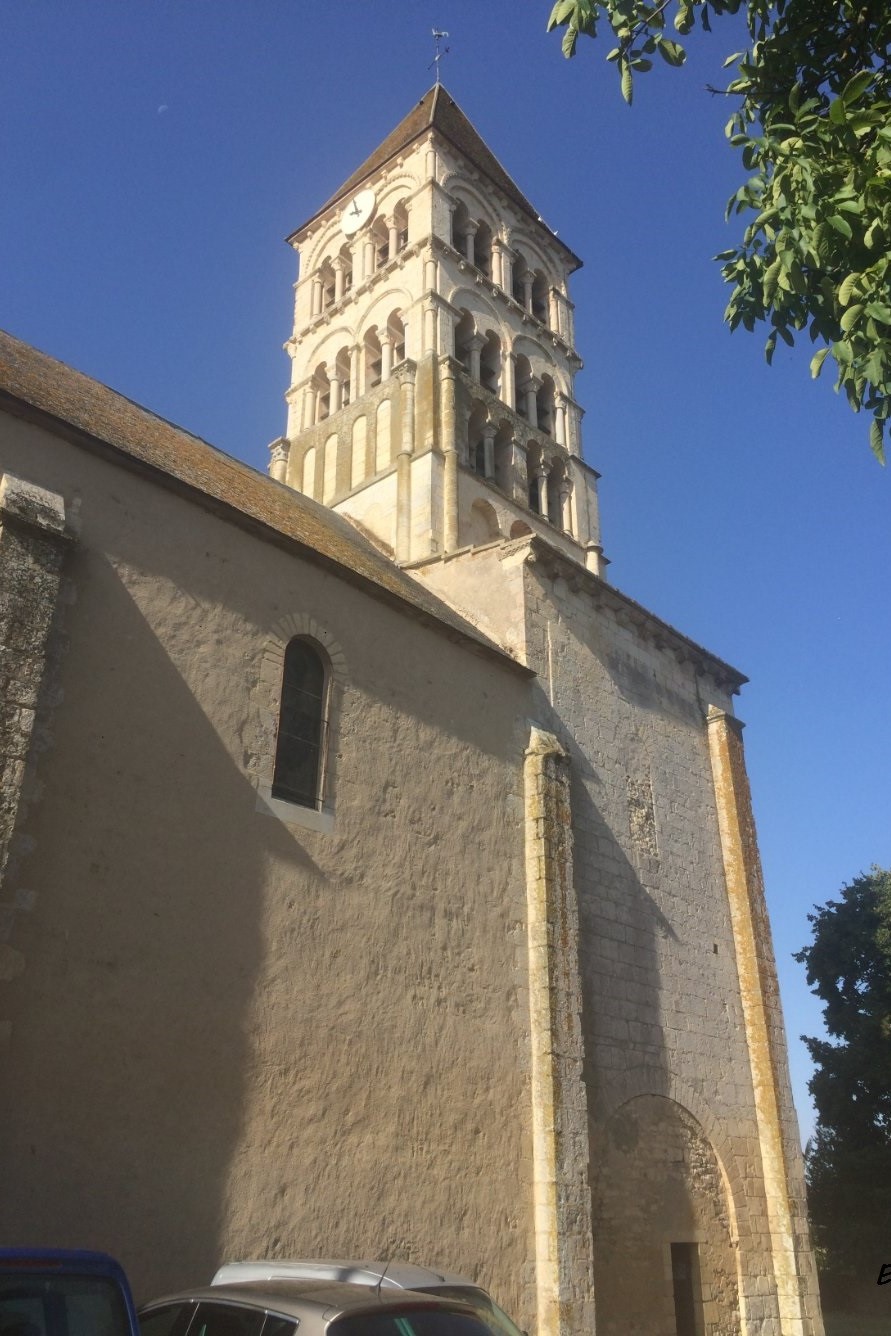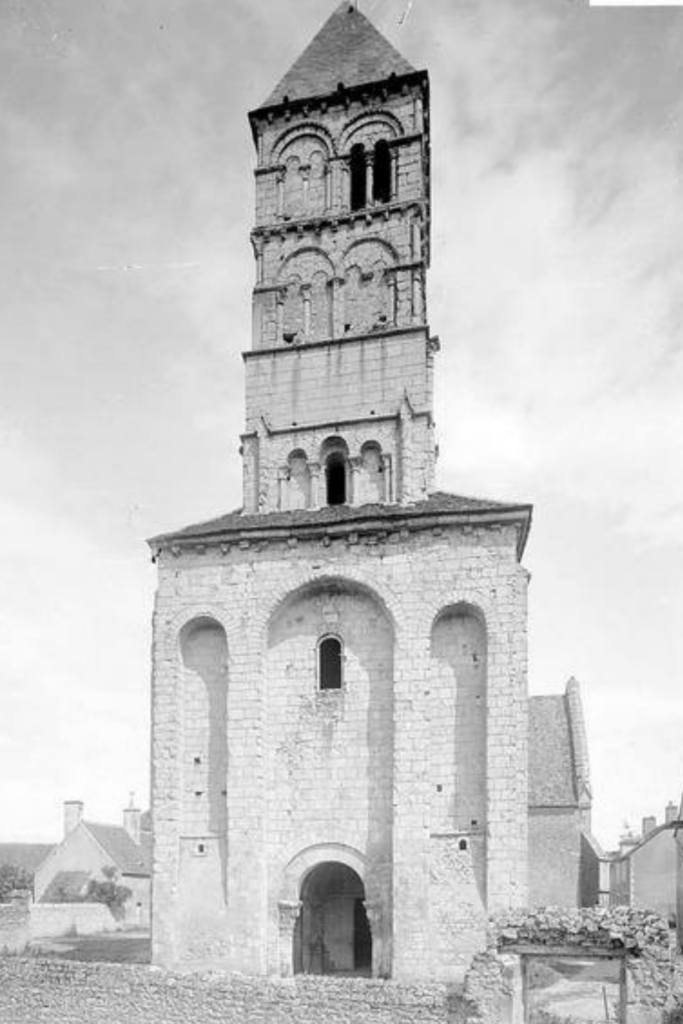Emmanuel Legeard’s historical investigation ”Germigny-L’Exempt ou les Trois Deniers de Gaspard” (L’Harmattan) reveals the unsuspected treasures of a small Cher village.
Who knows Germigny-L’Exempt? Probably not many, apart from the 300 or so people who live there. And yet, it wasn’t always so. The imposing Romanesque church of Notre-Dame de Germigny, built in the 12th century on the border between the Bourbonnais and Nivernais regions, is a reminder of the area’s prestigious past. The Germigny citadel was the most powerful fortress of the Bourbons around the year 1000.
Three gold coins

The 35-meter-high bell tower, built after the siege of 1108 by Louis VI le Gros as a symbol of God’s peace, still bears witness to this. But how are we to understand the mysterious iconographic program of the inner portal (1215) if we don’t know, as Emmanuel Legeard reveals, that it is inherited from the north porch of the west portal of the abbey church of Saint-Gilles du Gard and the north porch of the west portal of Laon Cathedral? The tympanum depicts the Mystery of the Incarnation in the form of a Virgin in majesty, flanked by the Annunciation and the Adoration of the Magi. Gaspard, kneeling at the foot of the Virgin’s throne, holds out three gold coins to the Infant Jesus.
For seven years, Emmanuel Legeard has been conducting a meticulous historical investigation based on these rich architectural elements, strange symbols and little-known ancient texts.
“France in formation”
An investigation into Gaspard’s three golden denarii that takes the reader on a whirlwind of exciting historical adventures, from the Fourth Crusade to the Albigensian Crusade.
“The primary aim of this book is to situate the art and architecture of the French medieval church of Germigny-l’Exempt in the world-historical context of the formation of France in the 12th and 13th centuries,” explains the author.”
In the book’s preface, Pierre Bonte writes: “You can’t understand France if you haven’t taken the measure of that deep feeling shared by all French people: the love of the steeple. From Joachim du Bellay, who liked “his little Liré better than Mount Palatine”, to the town clerk who published a booklet on local history at his own expense, it has inspired an astonishing abundance of literature.
- A student of French civilization specialist Pierre Brunel, Emmanuel Legeard holds a doctorate in literature from Pari-IV Sorbonne. Here, he presents the results of seven years’ historical research into the birth of an exemplary village in an emerging France.
“Germigny-L’Exempt ou Les Trois Deniers de Gaspard- Six essais autour d’un monument d’art et d’histoire” by Emmanuel Legeard. Éditions L’Harmattan. 20.50 euros.
Order here: https://www.germigny.com/
Interview with Emmanuel Legeard

-Why this interest in Germigny-L’Exempt?
You know how you get caught up in a case. It’s pretty much always the same. You think you know something, you anticipate confirmation, and what comes up is totally baffling. Then something clicks, you get a jolt of dopamine, as the physiologists say, and you’re hooked – sometimes for life. So my interest in Germigny came from a contrast and a discovery. At the time, there was very little information on Germigny, scattered throughout a few supposedly serious works where, often, the toponym isn’t even spelled correctly: most frequently, God knows why, it’s “Germiny” – and I’m not talking about the erratic locations, with Germigny-l’Exempt wandering surprisingly between the Allier, the Nièvre, the Creuse, or downright in “the north of France”! In short, I’d read that there were “evangelists”, “rivers of paradise”, that the column-statues on the portal jambs were “King Solomon” and “the Queen of Sheba”, that the tympanum depicted “the Adoration of the Magi”, that the portal was tiny. And then I found myself standing in front of this colossal bell tower that Yves Esquieu had never heard of, in front of this portal that Jean Wirth had never seen. And nothing matched the descriptions I’d read, apart from Willibald Sauerländer’s succinct notice and Gilberte Vezin’s evasive commentary on the Magi.
An enigma to be solved
Clearly, the only two serious historians who had actually been to Germigny were these two authors: Vezin, circa 1945, and Sauerländer, circa 1965. Everything else was fake. There were no evangelists, no rivers of paradise, no column statues, and the tympanum did not fundamentally represent the “Adoration of the Magi”, but the mystery of the Incarnation, with a splendid sedes sapientiae in the center, flanked by the Magi, naturally, and the Annunciation, which is rarer. The portal, which was decorated with extreme refinement, was high and wide, contrary to the descriptions I had read, and above all it had been given the appearance of a miniature cathedral portal, which was perfectly unusual. So the questions I asked myself, first of all, were: firstly, why such an improbable bell tower-porch in such an insignificant little town, and secondly, why a miniature cathedral portal in a parish church seemingly lost in the middle of nowhere? Both elements pointed to Germigny’s unique status, the reasons for which had to be sought by tracing its history. At the same time, it was important to determine whether there had been any column statues, what they had represented, and to identify the figures on the consoles who could not be, despite the endlessly repeated silliness, even in academic journals, a “river of paradise” or an “evangelist”. On the other hand, there was one element that no one was talking about, not even Sauerländer, and which only Vezin had seen as I had: the gift of coins. Now, for several reasons – and Françoise Perrot was later to confirm this – if it was an allusion to the Gospel of the Pseudo-Matthew, this allusion did not exhaust the meaning of the image. It remained an enigma to be elucidated by the context.
Everyone slipped away
It took me years to piece together the history of Germigny. Years to understand that a bell tower of this height had been erected to visually supplant the now-demolished keep of the citadel subdued by Louis VI in the name of God’s peace. Years to show that the miniature cathedral portal reflected the special status of Germigny, which was placed directly under the jurisdiction of the Archbishop of Bourges and represented an important stop on the circuit of pastoral visits, not least because the parvis or porch of Notre-Dame hosted officiality trials (i.e. an ecclesiastical tribunal). At first, I didn’t want to do the work myself. So I tried to contact the specialists I thought most competent, starting with Sauerländer, who wasn’t thrilled with the memory of Germigny and told me he only remembered a “rather ugly” portal. I offered everyone an all-expenses-paid place to stay. Everyone balked. Germigny was definitely of no interest to anyone! Finally, Sauerländer said something along the lines of: “You’re on the spot, you’ve got the necessary skills, so do the work yourself. So off I went, with no means of my own, and facing a whole series of unforeseen pitfalls. To compensate, there were some providential elements that enabled me to move forward: first the discovery of Françoise Perrot’s work, then a vigorous push back on track by Jean Wirth, and then the support of Guy Devailly, who was the great specialist in medieval Berry.
Les deniers de Gaspard
Françoise Perrot, above all, illuminated for me the significance of Gaspard’s deniers. From then on, the adventure began, the connection between the Archbishop of Bourges, who commissioned the portal, and the Albigensian Crusade, the three denarii levied on heretical households in recognition of the authority of the Church of Rome, of which the Virgin in Majesty was the allegory… Suddenly, the meaning became clear: the theocratic dimension of the portal, built after the fallout from the Fourth Crusade, at a time when the Lateran Council was validating the achievements of the Gregorian reform, and in the diocese of Bourges, where the Investiture Dispute had resulted in the triumph of the Pope over the King of France – all of this made it possible to understand the assimilation of the Magi to the Crusader kings, a metaphor popularized between the end of the 12th and the beginning of the 13th centuries. In short, I did the work. I did the work, I tried to do it as best I could, it was the first time Germigny had been mentioned again, fifty years after Sauerländer’s Gotische Skulptur in Frankreich, and I’m happy to think that he or Devailly, who are no longer with us, wouldn’t have been too disappointed with the final result, since elite medievalists as different, and as serious, as Pierre and Hélène Toubert, Jean Wirth, Julien Théry and Sylvain Gouguenheim all speak so highly of it.
-How is this small French village part of France’s great history?
Before falling into oblivion and insignificance, from the early Middle Ages to the Renaissance, Germigny was a very important place. In fact, it gave its name to one of the five “countries” of Berry, the Vallée de Germigny, which it dominated politically, notably through its Fiefs tower, from which the local lords extended their right of suzerainty over neighboring castellanies. In the early Middle Ages, the Merovingian villa of Germigny is already cited as a reference in the legend of Saint Austrégésile. In the Middle Ages, it was the most formidable citadel of the first House of Bourbon. At the end of the important Investiture Quarrel in Bourges, when Louis VII renounced the Caesaropapist prerogatives inherited from the Carolingians, Germigny became a symbol of the triumph of pontifical theocratic principles in Berry. During the Hundred Years’ War in 1358, the town was ravaged and occupied by Bertucat d’Albret’s Anglo-Navarra company, then sold for a staggering sum to Louis II de Bourbon, who took two years to raise the necessary gold: 14,000 florins! Germigny was not forgotten until François I confiscated the property of the Constable de Bourbon in 1527. Indeed, in the 16th century, the whole of Berry was out of the story. The Grand Condé’s exploits during the Fronde, with the sieges of Montrond and Sancerre, and the demolition of the Grosse Tour de Bourges by Louis XIV, were still to come, but the explosion of the Grosse Tour was a symbol of the end.
The siege of Louis VI in 1108
To return to Germigny, it’s above all the siege of 1108 that has associated the town with history. To be terse, if there is a Luis Alfonso de Borbon in Spain today who can claim the throne of France and the name Louis XX, it’s because of Germigny. Yet, inexplicably, no one had ever been interested in this seat of Louis VI in 1108. In fact, it had never even been mentioned in history books. And when, extraordinarily, Philippe Contamine cites Germigny in his Guerre au Moyen Âge (War in the Middle Ages), published by PUF in 1999, it’s totally insignificant and marginal within the enumeration: “the little war against the local tyrants didn’t stop for all that: 1109 (sic), siege of Germigny-l’Exempt”. The Germigny episode had nothing to do with a “small war” against “local tyrants”. It was an operation to vassalize a strong man whom Louis VI wanted to bring into his family, and whom he wished to camp against the very turbulent Counts of Auvergne. Moreover, Aymon de Bourbon did not “tyrannize” anyone! He is only accused of having surreptitiously robbed his nephew, Archambaud, who has lost his father, and whose mother has remarried to Alard Guillebaud, seigneur de La Roche. This Alard, who complained to Louis VI, may have displeased the court, but he had the merit of providing a pretext. Moreover, Suger, the architect of the fusion of the peace of God with the peace of the kingdom, was clearly going to encourage the Capetian to arm himself with ecclesiastical jurisdiction to lead a punitive expedition against Aymon. But God’s peace is still an alibi, as “the poor and the churches” are in no way threatened. For Suger, what was at stake was showing that, as peacemaker king and armed arm of the Church, Louis VI had a “long hand”, in other words, that he was not afraid to extend his reach far beyond his private domain. Louis therefore put himself at the head of a “formidable army” and marched down from Sens to lay siege to Germigny.
A new strategic location
But what’s most surprising is that Aymon came to await Louis VI’s arrival in lands now contiguous to the Capetian domain, since Bourges and Dun-sur-Auron had been annexed by Philip I in 1101. Yet it would have been easy for him to take refuge in some impregnable stronghold deep in the Auvergne. But to properly interpret the geostrategic aspects of the territory, we must first retrace its history at the time of the siege. The Bourbons were originally “knights of Berry”, i.e. they depended on the county of Bourges, held until the 10th century by the Guilhemides, and on the diocese of Bourges, based on the Gallo-Roman city of the Bituriges. So today’s Bourbonnais was part of Berry. William the Pious, Duke of Aquitaine and Count of Bourges, had placed Aymard, patriarch of the first House of Bourbon, at the head of several vigueries. This was the starting point of the Bourbon principality. Then, in 990, when Landry, Count of Nevers, threatened to encroach on Berry, Archbishop Dagbert of Bourges, himself a Bourbon, called on Archambaud II to “protect” Germigny. It’s a little family combination: Germigny’s benefices, which used to go to the chapter of Sainte-Croix d’Orléans, will now go to Dagbert. As for Archambaud, he nibbled away at a new strategic position on the borders of his “principality”. Finally, in the last quarter of the 11th century, Archambaud IV was to fortify Germigny. This was more or less the situation at the time of the spoliation affair.
A strange siege
When we examine the distribution of the major roles in this affair, the event takes shape. Firstly, Archbishop Léger of Bourges was on excellent terms with Alard Guillebaud because they had Robert d’Arbrissel as a mutual friend. But he was also on good terms with Aymon II de Bourbon, who was devoted to him. Léger was also a man who supported the interests of the Capetians. Everything suggests that he played a mediating role. As for Louis VI, we know what he wanted: to put the Bourbons at his service, to bind them by contracts such as the Saint-Pourçain oath, and by blood ties by marrying them into his family. In this context, it is highly likely that Aymon de Bourbon was diplomatically persuaded by Léger to place himself within the reach of Louis VI, so that he could more easily pay homage to the king in return for a parody of a siege. Indeed, when Louis goes to war, he usually means business. He forces his way into Meulan, burns down Le Puiset, ravages the Vexin, Raoul de Vermandois is cut open at Livry… In Germigny, nothing happens. A “strange siege” settled in peacefully. There’s no mention of battering rams or incendiary projectiles. It’s not war, it’s just a country game. And then, suddenly, Aymon de Bourbon bursts into the camp unannounced and rolls several times on the ground at the feet of Louis VI, who was clearly just waiting for him. The scene is described by Suger, who recalls the astonishment of the witnesses present.
In the royal family
Meanwhile, Aymon accompanied Louis VI “to France”, where they immediately did business behind closed doors. Even Suger was not admitted to the arrangements agreed by both parties. Aymon loses Germigny, but he is not punished in any way, and is even showered with benefits. He kept the fruit of his spoliation and officially became master of Bourbonnais, while his son married Louis VI’s sister-in-law. So it’s clear that Germigny was not, as some have written, a “small war” against “local tyrants”. There is neither tyrant nor war, and the stakes go far beyond the local level. We’re dealing with a camouflaged diplomatic operation, and it’s a very important event for the time. The expedition resulted in a major step forward in the expansion of the Capetian domain and the protection of its borders. Finally, it was at Germigny that the Bourbons were invited to join the royal family.

